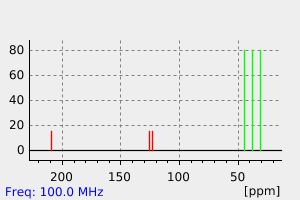1,2-dimethyl-1-cyclohexen-4-one | 33475-09-1
中文名称
——
中文别名
——
英文名称
1,2-dimethyl-1-cyclohexen-4-one
英文别名
3,4-dimethyl-3-cyclohexen-1-one;3,4-dimethyl-3-cyclohexenone;3,4-dimethylcyclohex-3-enone;1,2-Dimethyl-1-cyclohexen-4-on;3,4-Dimethyl-cyclohex-3-enon;3,4 Dimethylcyclohexen-3-on;3,4-Dimethylcyclohex-3-en-1-one
CAS
33475-09-1
化学式
C8H12O
mdl
——
分子量
124.183
InChiKey
WBZQYNKJZBACLL-UHFFFAOYSA-N
BEILSTEIN
——
EINECS
——
-
物化性质
-
计算性质
-
ADMET
-
安全信息
-
SDS
-
制备方法与用途
-
上下游信息
-
文献信息
-
表征谱图
-
同类化合物
-
相关功能分类
-
相关结构分类
计算性质
-
辛醇/水分配系数(LogP):0.6
-
重原子数:9
-
可旋转键数:0
-
环数:1.0
-
sp3杂化的碳原子比例:0.62
-
拓扑面积:17.1
-
氢给体数:0
-
氢受体数:1
反应信息
-
作为反应物:描述:参考文献:名称:Jacquesy,R.; Patoiseau,J.-F., Bulletin de la Societe Chimique de France, 1978, vol.
, p. 255 - 262 摘要:DOI: -
作为产物:描述:1-methoxy-4,5-dimethylcyclohexa-1,4-diene 以30.0 g的产率得到1,2-dimethyl-1-cyclohexen-4-one参考文献:名称:Factors influencing conformational preferences in cyclohexenes摘要:DOI:10.1021/ja00312a030
文献信息
-
Asymmetric Approach toward Chiral Cyclohex-2-enones from Anisoles via an Enantioselective Isomerization by a New Chiral Diamine Catalyst作者:Jung Hwa Lee、Li DengDOI:10.1021/ja308623n日期:2012.11.7A 3-step asymmetric approach toward the optically active chiral cyclohex-2-enones from anisoles has been developed. The crucial asymmetric induction step is an unprecedented catalytic enantioselective isomerization of β,γ-unsaturated cyclohex-3-en-1-ones to the corresponding α,β-unsaturated chiral enones. This new asymmetric transformation was realized by cooperative iminium-base catalysis with an
-
Reaction of Enamines with Acetals or Trialkyl Orthoformates Activated by Lewis Acids作者:Osamu Takazawa、Kunio Kogami、Kazuo HayashiDOI:10.1246/bcsj.57.1876日期:1984.7Enamines, prepared readily from various carbonyl compounds, react with acetals or trialkyl orthoformates in the presence of Lewis acids such as BF3·OEt2 to give corresponding β-alkoxy carbonyl compounds or α-dialkoxymethyl carbonyl compounds in good yields. The reaction of dienamines with acetals or trialkyl orthoformates also selectively gives corresponding β,γ-unsaturated α-(α-alkoxyalkyl) carbonyl compounds
-
Oxidative desulfonylation. Phenyl vinyl sulfone as a ketene synthetic equivalent作者:R.Daniel Little、Sun Ok MyongDOI:10.1016/s0040-4039(00)78683-7日期:1980.1α-Sulfonyl carbanions undergo oxidative desulfonylation to form ketones upon treatment with molybdenum peroxide MoO5·Py·HMPA (MoOPH) in THF at −78°C.在-78°C下用过氧化钼MoO 5 ·Py·HMPA(MoOPH)在THF中处理后,α-磺酰基碳负离子进行氧化脱磺酰化反应生成酮。
-
Glucocorticoid receptor modulators申请人:Dow L. Robert公开号:US20070117805A1公开(公告)日:2007-05-24The present invention provides non-steroidal compounds of formula I which are selective modulators (i.e., agonists and antagonists) of a steroid receptor, specifically, the glucocorticoid receptor. The present invention also provides pharmaceutical compositions containing these compounds and methods for using these compounds to treat animals requiring glucocorticoid receptor agonist or antagonist therapy. Glucocorticoid receptor modulators are useful to the diseases, such as obesity, diabetes, inflammation and others as described below. The present invention also provides intermediates and processes for preparing these compounds.
-
Cycloaddition Reactions of 1-Phenylseleno-2-(<i>p</i>-toluenesulfonyl)ethyne作者:Thomas G. Back、Richard J. Bethell、Masood Parvez、Jerry A. Taylor、Daniel WehrliDOI:10.1021/jo990730t日期:1999.10.11-Phenylseleno-2-(p-toluenesulfonyl)ethyne (1) is an effective dienophile and dipolarophile. It underwent facile Diels-Alder reactions with a variety of dienes to afford vicinal sulfone- and selenide-functionalized 1,4-cyclohexadienes. Unexpected regiochemistry that is the opposite of what is obtained with simple acetylenic sulfones was observed with several unsymmetrical dienes containing methyl or methoxy substituents at the 1- or 2-position. Acetylene 1 reacted with (trimethylsilyl)methyl azide, diazomethane, and 2,4,6-trimethylbenzonitrile N-oxide via 1,3-dipolar cycloadditions to afford the corresponding triazole, 1,2-diazole, and isoxazole products. It also underwent an ene reaction with beta-pinene that showed anomalous regiochemistry compared to other acetylenic sulfones. The Diels-Alder cycloadducts obtained from the reaction of 1 with 2,3-dimethyl-1,3,butadiene and 1,3-cyclohexadiene were readily converted into the corresponding beta-keto sulfones and ketones, thus rendering 1 as the synthetic equivalent of p-toluenesulfonylketene and ketene, respectively. Base-catalyzed elimination of TsOH from the Diels-Alder cycloadduct obtained with 2,3-dimethyl-1,3-butadiene afforded the corresponding aryl phenyl selenide, while the adduct from piperylene underwent oxidation to its selenoxide, followed by a Pummerer-type reaction to produce 2-(phenylseleno)-3-(p-toluenesulfonyl)toluene. The reaction of the bicyclic Diels-Alder product obtained from 1,3-cyclohexadiene with MeCu(SePh)Li resulted in substitution of the phenylseleno moiety by a methyl group, whereas similar treatment, of the monocyclic adduct derived from piperylene effected elimination of PhSeH and aromatization.
表征谱图
-
氢谱1HNMR
-
质谱MS
-
碳谱13CNMR
-
红外IR
-
拉曼Raman
-
峰位数据
-
峰位匹配
-
表征信息
同类化合物
(反式)-4-壬烯醛
(s)-2,3-二羟基丙酸甲酯
([1-(甲氧基甲基)-1H-1,2,4-三唑-5-基](苯基)甲酮)
(Z)-4-辛烯醛
(S)-氨基甲酸酯β-D-O-葡糖醛酸
(S)-3-(((2,2-二氟-1-羟基-7-(甲基磺酰基)-2,3-二氢-1H-茚满-4-基)氧基)-5-氟苄腈
(R)-氨基甲酸酯β-D-O-葡糖醛酸
(5,5-二甲基-2-(哌啶-2-基)环己烷-1,3-二酮)
(2,5-二氟苯基)-4-哌啶基-甲酮
龙胆苦苷
龙胆二糖甲乙酮氰醇(P)
龙胆二糖丙酮氰醇(P)
龙胆三糖
龙涎酮
齐罗硅酮
齐留通beta-D-葡糖苷酸
鼠李糖
黑芥子苷单钾盐
黑海棉酸钠盐
黑木金合欢素
黑曲霉三糖
黑介子苷
黄尿酸8-O-葡糖苷
麻西那霉素II
麦迪霉素
麦芽糖脎
麦芽糖基海藻糖
麦芽糖1-磷酸酯
麦芽糖
麦芽四糖醇
麦芽四糖
麦芽十糖
麦芽六糖
麦芽五糖水合物
麦芽五糖
麦芽五糖
麦芽五糖
麦芽三糖醇
麦芽三糖
麦芽三糖
麦芽三塘水合
麦芽七糖水合物
麦芽七糖
麦法朵
麦可酚酸-酰基-Β-D-葡糖苷酸
麦利查咪
麝香酮
鹤草酚
鸢尾酚酮 3-C-beta-D-吡喃葡萄糖苷
鸡矢藤苷







